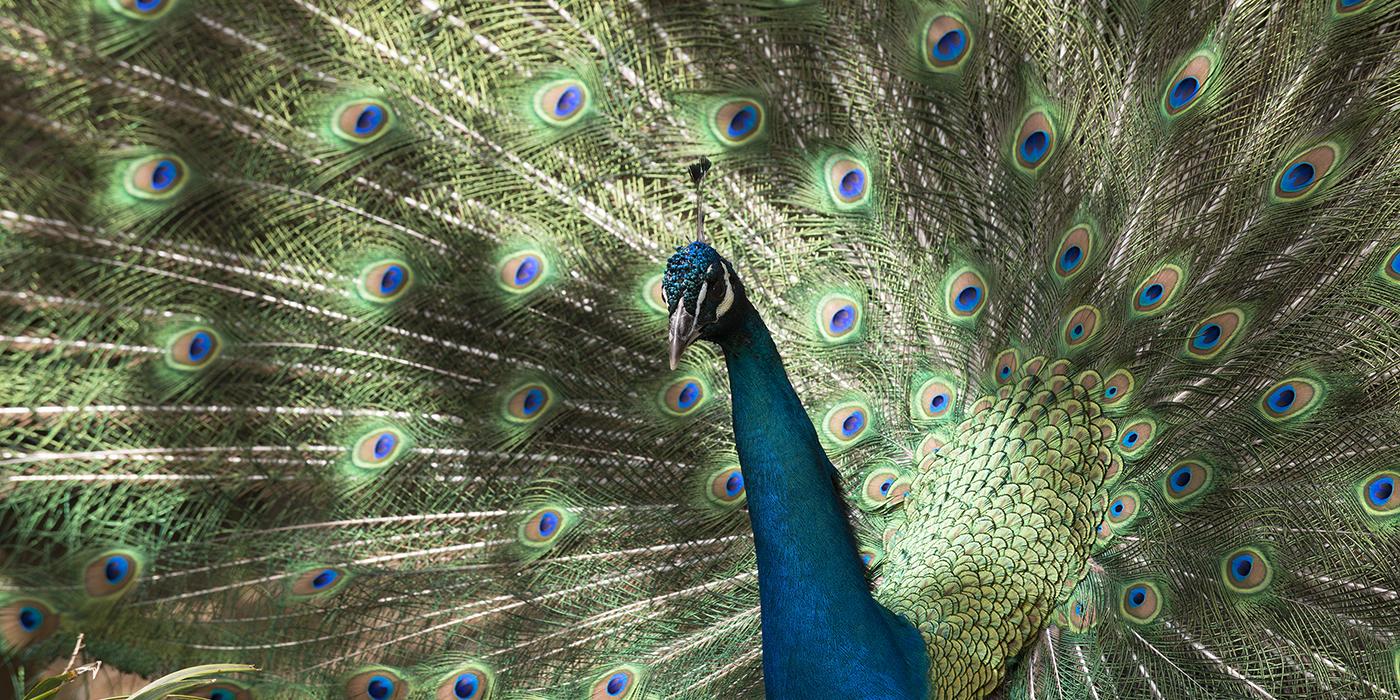Physical Description
Males boast extravagant colors, elaborate feathers, showy displays or all three. Elongated upper tail feathers form the 5-foot (1.7-meter) train for which the peacock is famous. These feathers are metallic green, and are decorated with iridescent ocelli, or eyespots, ringed with blue and bronze.
A male may sport from 100-175 ocelli — the fanned train display is designed to show off every one. Females, also called peahens, are smaller and more drably colored, with a shorter train that lacks ocelli.
Size
Peafowl are the largest members of the pheasant family. At up to 13 pounds (6 kilograms), peafowl are among the heaviest of flying birds, although they prefer walking and running to flying.
Native Habitat
Peafowl are native to Sri Lanka and India, where they are the national bird. They live in open forests near streams, and are also found in cultivated areas and around Buddhist and Hindu temples.
Phoenicians first brought peafowl from India to what is now Syria and Egypt about 3,000 years ago. About 600 years later, Alexander the Great introduced them to Greece, where he forbade people to harm them. In Roman times, however, peafowl were served at the lavish banquets of the wealthy; the peafowls' tongues were particular delicacies.
English barons in the Middle Ages offered roasted peafowl to their guests, who often dined while listening to peacocks calling on the lawn
Food/Eating Habits
Peafowl are omnivorous. They forage on the ground for diverse food items, including berries and other fruits, grain and green crops, insects, and small reptiles, mammals and snakes.
Social Structure
Peacocks form leks — aggregations of very small territories, each owned by one male. The males display by shaking their fanned trains to reinforce the effect for any females visiting the lek, making it easy for a female to assess several males before choosing one to mate with.
Reproduction and Development
Females select mates based on the number of ocelli in their tail. Male peacocks with the greatest number of ocelli win the most females. The number of ocelli and the length of the train feathers increase between the ages of four and 12, so scientists speculate that these traits broadcast a male's age and perhaps also his vigor and status.
The peahen lays four to eight eggs in a depression scratched on the ground and hidden among vegetation. Males don't share in parental care. Females alone incubate the eggs for about 30 days. Young hatch fully-formed and can run and feed themselves almost immediately after hatching.
Conservation Efforts
The peafowl's religious significance, which has largely protected them from exploitation, and their ability to thrive in human-dominated landscapes, mean that they are currently secure in the wild.
Help this Species
Share the story of this animal with others. Simply raising awareness about this species can contribute to its overall protection.
Are you a student? Did you love what you learned about this animal? Make it the topic of your next school project, or start a conservation club at your school. You'll learn even more and share the importance of saving species with classmates and teachers, too.
Smithsonian's National Zoo and Conservation Biology Institute. (n.d.). Common peafowl. Retrieved December 1, 2025, from https://nationalzoo.si.edu/animals/common-peafowl
Animal News

Giant Panda Qing Bao Gets a Checkup ›

7 Spooktacular Animal Facts for Halloween ›

